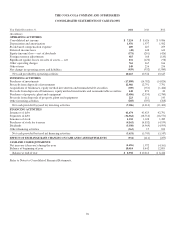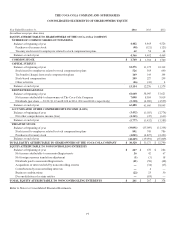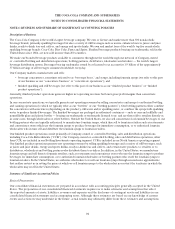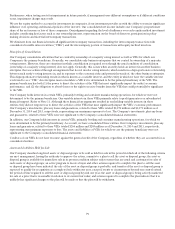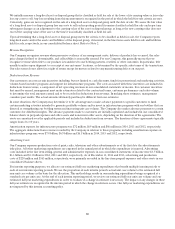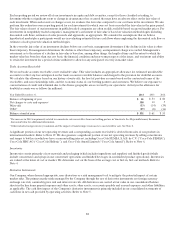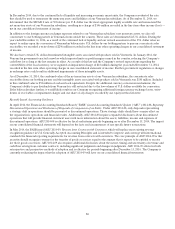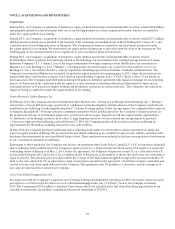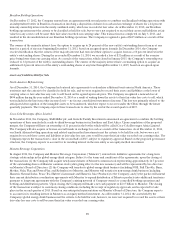Coca Cola 2014 Annual Report Download - page 82
Download and view the complete annual report
Please find page 82 of the 2014 Coca Cola annual report below. You can navigate through the pages in the report by either clicking on the pages listed below, or by using the keyword search tool below to find specific information within the annual report.80
We initially measure a long-lived asset or disposal group that is classified as held for sale at the lower of its carrying value or fair value
less any costs to sell. Any loss resulting from this measurement is recognized in the period in which the held-for-sale criteria are met.
Conversely, gains are not recognized on the sale of a long-lived asset or disposal group until the date of sale. We assess the fair value
of a long-lived asset or disposal group less any costs to sell each reporting period it remains classified as held for sale and report any
subsequent changes as an adjustment to the carrying value of the asset or disposal group, as long as the new carrying value does not
exceed the carrying value of the asset at the time it was initially classified as held for sale.
Upon determining that a long-lived asset or disposal group meets the criteria to be classified as held for sale, the Company reports
long-lived assets and/or the assets and liabilities of the disposal group, if material, in the line items assets held for sale and liabilities
held for sale, respectively, in our consolidated balance sheet. Refer to Note 2.
Revenue Recognition
Our Company recognizes revenue when persuasive evidence of an arrangement exists, delivery of products has occurred, the sales
price charged is fixed or determinable, and collectibility is reasonably assured. For our Company, this generally means that we
recognize revenue when title to our products is transferred to our bottling partners, resellers or other customers. In particular, title
usually transfers upon shipment to or receipt at our customers’ locations, as determined by the specific sales terms of the transactions.
Our sales terms do not allow for a right of return except for matters related to any manufacturing defects on our part.
Deductions from Revenue
Our customers can earn certain incentives including, but not limited to, cash discounts, funds for promotional and marketing activities,
volume-based incentive programs and support for infrastructure programs. The costs associated with these incentives are included in
deductions from revenue, a component of net operating revenues in our consolidated statements of income. For customer incentives
that must be earned, management must make estimates related to the contractual terms, customer performance and sales volume
to determine the total amounts earned and to be recorded in deductions from revenue. In making these estimates, management
considers past results. The actual amounts ultimately paid may be different from our estimates.
In some situations, the Company may determine it to be advantageous to make advance payments to specific customers to fund
certain marketing activities intended to generate profitable volume and/or invest in infrastructure programs with our bottlers that are
directed at strengthening our bottling system and increasing unit case volume. The Company also makes advance payments to certain
customers for distribution rights. The advance payments made to customers are initially capitalized and included in our consolidated
balance sheets in prepaid expenses and other assets and noncurrent other assets, depending on the duration of the agreements. The
assets are amortized over the applicable periods and included in deductions from revenue. The duration of these agreements typically
ranges from 4 to 10 years.
Amortization expense for infrastructure programs was $72 million, $69 million and $86 million in 2014, 2013 and 2012, respectively.
The aggregate deductions from revenue recorded by the Company in relation to these programs, including amortization expense on
infrastructure programs, were $7.0 billion, $6.9 billion and $6.1 billion in 2014, 2013 and 2012, respectively.
Advertising Costs
Our Company expenses production costs of print, radio, television and other advertisements as of the first date the advertisements
take place. All other marketing expenditures are expensed in the annual period in which the expenditure is incurred. Advertising
costs included in the line item selling, general and administrative expenses in our consolidated statements of income were $3.5 billion,
$3.3 billion and $3.3 billion in 2014, 2013 and 2012, respectively. As of December 31, 2014 and 2013, advertising and production
costs of $228 million and $363 million, respectively, were primarily recorded in the line item prepaid expenses and other assets in our
consolidated balance sheets.
For interim reporting purposes, we allocate our estimated full year marketing expenditures that benefit multiple interim periods to
each of our interim reporting periods. We use the proportion of each interim period’s actual unit case volume to the estimated full
year unit case volume as the basis for the allocation. This methodology results in our marketing expenditures being recognized at a
standard rate per unit case. At the end of each interim reporting period, we review our estimated full year unit case volume and our
estimated full year marketing expenditures in order to evaluate if a change in estimate is necessary. The impact of any changes in these
full year estimates is recognized in the interim period in which the change in estimate occurs. Our full year marketing expenditures are
not impacted by this interim accounting policy.








